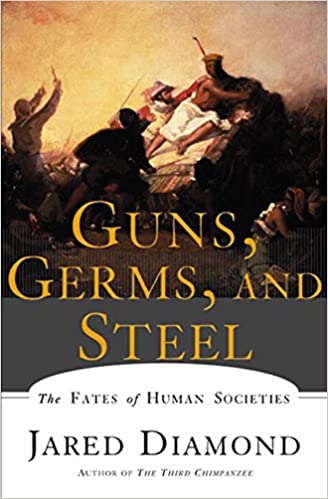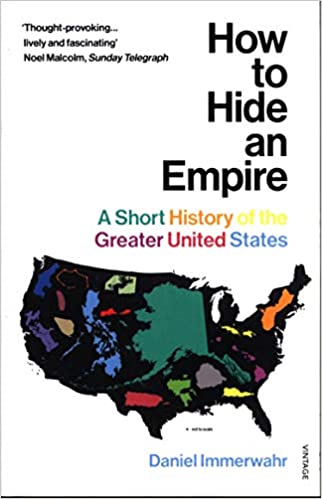By Harold C. Ford
Two recent reads provide some historical context for the current coronavirus pandemic:
Guns, Germs, and Steel by Jared Diamond (1999, W. W. Norton & Company) traces the long history of human pandemics to the domestication of animals.
How to Hide an Empire, A Short History of the Greater United States, by Daniel Immerwahr (2019, The Bodley Head) details the racial inequities of health care and research by political, scientific, and medical leaders in the United States.
While neither read focuses exclusively on the aforementioned themes, significant portions of both books help explain the historical roots of global health crises and the color-conscious mis-administration of the benefits and burdens of medical care.
Guns, Germs, and Steel:
 In his Pulitzer Prize winning book, Diamond makes clear the role that disease and technology play in Europe’s domination of global politics for the past five centuries. The domestication of plants and animals, and subsequent disease, that spread from Southwest Asia’s Fertile Crescent to the European landmass was critical to the emergence of that dominance.
In his Pulitzer Prize winning book, Diamond makes clear the role that disease and technology play in Europe’s domination of global politics for the past five centuries. The domestication of plants and animals, and subsequent disease, that spread from Southwest Asia’s Fertile Crescent to the European landmass was critical to the emergence of that dominance.
“Smallpox, measles, influenza, typhus, bubonic plague, and other infectious diseases endemic in Europe played a decisive role in European conquests,” writes Diamond, “by decimating many peoples on other continents.”
No weapons technology ever conjured up by humans was as efficient as disease in eliminating huge swaths of our species.
“Throughout the Americas,” Diamond writes, “diseases introduced with Europeans spread from tribe to tribe far in advance of the Europeans themselves, killing an estimated 95 percent of the pre-Columbian Native American population.”
Historically, the efficiency of disease is evident at both macro- and micro-levels of the human experience. “For example,” continues Diamond, “in the winter of 1902 a dysentery epidemic brought by a sailor on the whaling ship Active killed 51 of the 56 Sadlermuit Eskimos, a very isolated band of people living on Southampton Island in the Canadian arctic.”
And the origins of these killer diseases? Blame the animals.
Blame the animals:
“The major killers of humanity throughout our recent history—smallpox, flu, tuberculosis, malaria, plague, measles, and cholera—are infectious diseases that evolved from diseases of animals,” declares Diamond. “Because diseases have been the biggest killers of people, they have also been decisive shapers of history.”
Over the past 10,000 years, our species has transitioned from nomadic hunter-gatherers to food producers enabled by the domestication of plants and animals. A more reliable source of food created more leisure time, spurred social classes, and inspired the growth of human culture. It also resulted in more sedentary lifestyles, population growth, and communities of denser population.
So-called “crowd diseases,” explains Diamond,” could have arisen only with the buildup of large, dense human populations.” Think of the aforementioned diseases and, more recently, H2N2 (1957-58), H3N2 (1968, influenza A), HIV-AIDS (1981 to the present), SARS (2002), and H1N1 (2009, swine flu).
The worst pandemic in human history was H1N1 (1918-19), the misnamed Spanish flu, that claimed 21 million lives, according to Diamond. Actually, death estimates for the Spanish flu, that likely began at a large army base in Kansas, vary widely from 20 million to 100 million.
For example, Adam Hochschild, in his critically acclaimed book, To End All Wars, A Story of Loyalty and Rebellion, 1914-18, estimates the Spanish flu death toll to be “50 million or more.”
Enlisted to spread the bad news:
“Microbes have evolved diverse ways of spreading from one person to another, and from animals to people,” Diamond writes. “The germ that spreads better leaves more babies and ends up favored by natural selection.”
“We become enlisted to spread microbes,” Diamond warns. “Microbes wait for one host to be eaten by the next host: for instance, salmonella bacteria, which we contract by eating already infected eggs or meat; (or) the worm responsible for trichinosis, which gets from pigs to us by waiting for us to kill the pig and eat it without proper cooking…
“Some microbes don’t wait for the old host to die and get eaten, but instead hitchhike in the saliva of an insect that bites the old host and flies off to find a new host,” Diamond reports. “The free ride may be provided by mosquitoes, fleas, lice, or tsetse flies that spread malaria, plague, typhus, or sleeping sickness.”
“From our point of view, genital sores, diarrhea, and coughing are ‘symptoms of disease,’” Diamond writes. “From a germ’s point of view, they’re clever evolutionary strategies to broadcast (and spread) the germ.”
Staying alive:
Diamond considers “our own selfish interests: to stay alive and healthy, best done by killing the damned germs.” He discusses three ways of “killing” these invisible and deadly invaders.
The first is to “bake the germs to death before we get baked ourselves.” We develop a fever.
A second “common response of ours is to mobilize our immune system (and create antibodies) …that actively seek out and kill foreign microbes.” However, “some clever microbes don’t just cave in to our immune defenses,” Diamond warns. “Some have learned to trick us by changing…”. Thus, new and various strains of the flu and other diseases.
The third and “slowest defensive response is through natural selection (wherein) some people “with genes for resistance to that particular microbe are more likely to survive than are people lacking such genes.”
Humans have “evolved countertricks of our own,” Diamond concludes, “to which the germs have responded by evolving counter-countertricks. We and our pathogens are now locked in an escalating evolutionary contest, with the death of one contestant the price of defeat, and with natural selection playing the role of umpire.”
“People with genes for resistance to that particular microbe are more likely to survive…(but) unfortunate individuals without the genes were less likely to survive to pass their genes on to babies,” concludes Diamond. “It does mean, though, that a human population as a whole becomes better protected against the pathogen.”
Disease and human history:
“Human diseases lie behind the broadest pattern of human history, and behind some of the most important issues in human health today,” reports Diamond. That includes racial disparities in the administration of health care.
How to Hide an Empire:
 In How to Hide an Empire, Daniel Immerwahr makes a convincing case that, by mid-20th century, the United States of America had actually transitioned into an empire—the fifth largest in the world in terms of population.
In How to Hide an Empire, Daniel Immerwahr makes a convincing case that, by mid-20th century, the United States of America had actually transitioned into an empire—the fifth largest in the world in terms of population.
“Nearly nineteen million people lived in the (American) colonies,” he writes, “the great bulk of them in the Philippines… (By 1940) slightly more than one in eight (12.6 percent) of the people in the United States lived outside of the states.”
Of eight colonial possessions, only Alaska and Hawaii, in 1959, would eventually achieve statehood. Statehood for the Philippines, Puerto Rico, the Panama Canal Zone, the U.S. Virgin Islands, Guam, and American Samoa would never be achieved as they were largely populated by black and brown peoples.
“The racism that had pervaded the country since slavery engulfed the territories, too,” writes Immerwahr. “Like African-Americans, colonial subjects were denied the vote, deprived of the rights of full citizens, called ‘nigger’, subjected to dangerous medical experiments, and used as sacrificial pawns in war.”
Dangerous medical experiments:
Three episodes that unfolded in American colonies aptly demonstrate the intersection of racism and medicine. “They (colonial possessions),” writes Immerwahr, “functioned as laboratories, spaces for bold experimentation where ideas could be tried with practically no resistance, oversight, or consequences.”
Puerto Rico, 1930s:
At the start of the 20th century, anemia was the leading cause of death in Puerto Rico, accounting for some 20 to 30 percent of mortality. By 1930, hookworm—the primary cause of that anemia—afflicted up to 90 percent of rural Puerto Ricans.
Puerto Rico’s dense population encouraged the spread of hookworms. The island’s governor, Leonard Wood, appointed by Franklin D. Roosevelt, believed that restricting births “among the lower and more ignorant elements of the population” was “the only salvation for the Island.”
Cornelius Rhoads, a mainland doctor trained at Harvard, arrived on the island and, according to Immerwahr, “appeared to regard Puerto Rico as an island-size laboratory.”
Rhoads refused treatment to some of his anemia patients so that he could compare their progress with treated patients,” writes Immerwahr. “He tried to induce anemia in others (he referred to them as ‘experimental animals’) by restricting their diets.
Rhoads fomented a rebellion by nationalist Puerto Ricans when the contents of a scathing letter made its way to the public. Some excerpts:
“Porto Ricans…are beyond doubt the dirtiest, laziest, most degenerate and thievish race of men ever…It makes you sick to inhabit the same island with them…What the island needs is…to totally exterminate the population…I have done my best to further the process of extermination by killing off 8 and transplanting cancer into several more.”
In 1940 Rhoads was made director of Memorial Hospital in New York. In 1942 he was elected vice president of the New York Academy of Medicine.
He became chief of the Chemical Warfare Service’s medical division which led the testing of gases and gear on more than 60,000 men in the American military. Some of the experiments were race based. “African Americans, Japanese Americans, and Puerto Ricans were tested to see if they would fare differently than whites against mustard agents,” writes Immerwahr.
At the end of World War II Rhoads was awarded a Legion of Merit for “combating poison gas and other advances in chemical warfare.” With a $4 million grant from Alfred P. Sloan, the president of General Motors, he continued researching mustard gas agents after the war. He made the cover of Time in 1949.
Puerto Rico, 1950s:
Into the 1950s, overpopulation was still viewed as an impediment to progress in Puerto Rico. Gregory Pincus, another physician and Harvard man from the mainland, arrived on the scene. Pincus, known as the father of the (birth control) pill viewed Puerto Rico as a suitable place where “certain experiments which would be very difficult in this country (U.S.).”
According to Immerwahr: “Puerto Rico became a laboratory for all sorts of experimental contraceptives: diaphragms, spermicidal jellies, spirals, loops, intrauterine devices, hormone shots, and an ‘aerosol vaginal foam’ known as ‘Emko’ distributed to tens of thousands of women.”
The practice of female sterilization began in Puerto Rican hospitals in the early 1940s. It grew to staggering proportions. “Of the (Puerto Rican) mothers born in the latter part of the 1920s, nearly half had been sterilized,” writes Immerwahr.
Bikini Atoll, 1950s, 1960s:
When the United States tested its first atomic bomb, scientists used desert land in New Mexico. Subsequent tests by the Atomic Energy Commission would take place far from the mainland. Government officials and scientists settled upon the Bikini Atoll in the Marshall Islands of the Pacific.
From 1946 to 1958 the U.S. detonated 68 nuclear weapons on or near Bikini. One such test was a fifteen-megaton hydrogen bomb dubbed “Bravo shot.” The fallout was devastating for some Pacific islanders.
“On Rongelap, more than a hundred miles from ground zero,” recounts Immerwahr, “islanders watched radioactive white ash fall from the sky like snow. (Eighty suffered from radiation poisoning, and the island had to be evacuated for three years.)”
The response of Henry Kissinger, then the country’s most esteemed nuclear expert, was typical of many. “There are only 90,000 people out there. Who gives a damn?”
Past is prologue:
Thus, our nation’s racist colonial history should serve as prologue to the present. Emerging racial disparities in our war with humanity’s newest microbial invader—coronavirus—should not surprise.
According to a report by the New York Times: “The coronavirus is infecting and killing black people in the United States at disproportionately high rates, according to data released by several states and big cities, highlighting what public health researchers say are entrenched inequalities in resources, health, and access to care.”
- “In Illinois, 43 percent of people who have died from the disease and 28 percent of those who have tested positive are African-Americans, a group that makes up just 15 percent of the state’s population.”
- “In Louisiana, about 70 percent of the people who have died are black, though only a third of that state’s population is.”
- “African-Americans, who account for a third of positive tests in Michigan, represent 40 percent of deaths in that state even though they make up 14 percent of the population.”
In an April 22 press statement released to the public, Michigan’s Lieutenant Governor, Garlin Gilchrist, chair of the Michigan Coronavirus Task Force on Racial Disparities, cited poverty, availability of health care, level of exposure, predeterminate factors such as obesity, rates of diabetes, and cardiac diseases as reasons for disparate impact on communities of color.
“These health disparities are something that has been present, when it comes to health outcomes, for generations in our state and, frankly, in our nation.”

Harold C. Ford (Photo by Jan Worth-Nelson)
EVM Education Beat reporter and Staff Writer Harold C. Ford can be reached at hcford1185@gmail.com.


You must be logged in to post a comment.